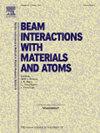用于核反应研究的同位素选择植入靶标
IF 1.4
3区 物理与天体物理
Q3 INSTRUMENTS & INSTRUMENTATION
Nuclear Instruments & Methods in Physics Research Section B-beam Interactions With Materials and Atoms
Pub Date : 2024-08-03
DOI:10.1016/j.nimb.2024.165485
引用次数: 0
摘要
本文介绍了通过离子注入法制备一些同位素选定靶的方法。选择这些同位素是因为它们与 NUMEN 项目(无中子双贝塔衰变的核基质元素)中研究双电荷交换反应所需的氙和氪同位素相似。利用卢瑟福反向散射光谱法(RBS),以不同的能量和散射角用 1H、12C 和 28Si 光束对植入后产生的目标进行了表征。本文章由计算机程序翻译,如有差异,请以英文原文为准。
Isotopically selected implanted targets for nuclear reaction studies
In this paper, the preparation of some isotopically selected targets by ion implantation is described. The selected isotopes to be implanted over graphite matrices described in the present work were 127I and 81Br. These isotopes were chosen for their similarity with the xenon and krypton isotopes of interest for the study of Double Charge Exchange reactions in the NUMEN project (Nuclear Matrix Elements for the Neutrino-less double beta decay). The characterization of the resulting targets after implantation was carried out using Rutherford Back Scattering Spectroscopy (RBS) with 1H, 12C, 28Si beams at different energies and scattering angles.
求助全文
通过发布文献求助,成功后即可免费获取论文全文。
去求助
来源期刊
CiteScore
2.80
自引率
7.70%
发文量
231
审稿时长
1.9 months
期刊介绍:
Section B of Nuclear Instruments and Methods in Physics Research covers all aspects of the interaction of energetic beams with atoms, molecules and aggregate forms of matter. This includes ion beam analysis and ion beam modification of materials as well as basic data of importance for these studies. Topics of general interest include: atomic collisions in solids, particle channelling, all aspects of collision cascades, the modification of materials by energetic beams, ion implantation, irradiation - induced changes in materials, the physics and chemistry of beam interactions and the analysis of materials by all forms of energetic radiation. Modification by ion, laser and electron beams for the study of electronic materials, metals, ceramics, insulators, polymers and other important and new materials systems are included. Related studies, such as the application of ion beam analysis to biological, archaeological and geological samples as well as applications to solve problems in planetary science are also welcome. Energetic beams of interest include atomic and molecular ions, neutrons, positrons and muons, plasmas directed at surfaces, electron and photon beams, including laser treated surfaces and studies of solids by photon radiation from rotating anodes, synchrotrons, etc. In addition, the interaction between various forms of radiation and radiation-induced deposition processes are relevant.

 求助内容:
求助内容: 应助结果提醒方式:
应助结果提醒方式:


